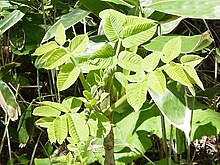Toxicodendron vernicifluum
| Toxicodendron vernicifluum | |
|---|---|

| |
| Scientific classification | |
| Kingdom: | |
| (unranked): | |
| (unranked): | |
| (unranked): | |
| Order: | |
| Family: | |
| Genus: | |
| Species: | T. vernicifluum
|
| Binomial name | |
| Toxicodendron vernicifluum (Stokes) F. Barkley
| |
Toxicodendron vernicifluum (formerly Rhus verniciflua[1]), also known with the common name Chinese lacquer tree,[1][2][3] is a species of genus Toxicodendron (formerly Rhus) that grows in East Asia, in regions of China, Korea and Japan. The trees are cultivated and tapped for their toxic sap, which is used as a highly durable lacquer to make Chinese, Japanese, and Korean lacquerware.
The trees grow up to 20 m tall with large leaves, each containing from 7 to 19 leaflets (most often 11-13). The sap contains the allergenic compound urushiol, which gets its name from this species' Japanese name urushi. Urushiol is the oil found in poison ivy that causes a rash.

Uses
A caustic, toxic sap, called urushiol, is tapped from the trunk of the Chinese lacquer tree to produce lacquer. This is done by cutting 5 to 10 horizontal lines on the trunk of a 10 year old tree, and then collecting the greyish yellow sap that exudes. The sap is then filtered, heat-treated, or coloured before applying onto a base material that is to be lacquered. Curing the applied sap requires "drying" it in a warm, humid chamber or closet for 12 to 24 hours where the urushiol polymerizes to form a clear, hard, and waterproof surface. In its liquid state, urushiol can cause extreme rashes, even from vapours. Once hardened, reactions are possible but less common.
Products coated with lacquer are recognizable by an extremely durable and glossy finish. Lacquer has many uses; some common applications include tableware, musical instruments, fountain pens, jewelry, and bows. There are various types of lacquerware. The cinnabar-red is highly regarded. Unpigmented lacquer is dark brown but the most common colors of urushiol finishes are black and red, from powdered pigments of iron and ferric oxide, respectively. Lacquer is painted on with a brush and is cured in a warm and humid environment.
Artistic application and decoration of lacquer can be a long process, requiring many hours or days of careful and repetitive layers and drying times. The creation of a single piece of urushi art, such as a bowl or a fountain pen, may take weeks to months to complete. Lacquer is a very strong adhesive.
The leaves, seeds, and the resin of the Chinese lacquer tree are sometimes used in Chinese medicine for the treatment of internal parasites and for stopping bleeding. Compounds butein and sulfuretin are antioxidants, and have inhibitory effects on aldose reductase and advanced glycation processes.[4]
See also
References
- Duke. J. A. and Ayensu. E. S. Medicinal Plants of China Reference Publications, Inc. 1985 ISBN 0-917256-20-4
- Stutler, Russ. "A Little more information on Urushi". December 2002.
- Suganuma, Michiko. "Japanese lacquer".
- ^ a b "PLANTS Profile for Toxicodendron vernicifluum (Chinese lacquer)". Natural Resources Conservation Service. United States Department of Agriculture. Retrieved 8 August 2011.
- ^ Yun-Yang, W (2006 May 30). "Purification and characterization of hydrosoluble components from the sap of Chinese lacquer tree Rhus vernicifera". International journal of biological macromolecules. 38 (3–5): 232–40. PMID 16580725.
{{cite journal}}: Check date values in:|date=(help); Unknown parameter|coauthors=ignored (|author=suggested) (help)CS1 maint: date and year (link) - ^ Mabberley, D.J. (2002). The plant-book: A portable dictionary of the vascular plants (2nd ed.). Cambridge, U.K.: Cambridge University Press. p. 286. ISBN 978-0-521-41421-0.
- ^ Lee EH, Song DG, Lee JY, Pan CH, Um BH, Jung SH (2008). "Inhibitory effect of the compounds isolated from Rhus verniciflua on aldose reductase and advanced glycation endproducts". Biol. Pharm. Bull. 31 (8): 1626–30. doi:10.1248/bpb.31.1626. PMID 18670102.
{{cite journal}}: Unknown parameter|month=ignored (help)CS1 maint: multiple names: authors list (link)
